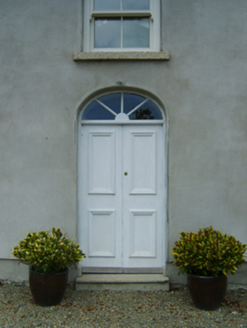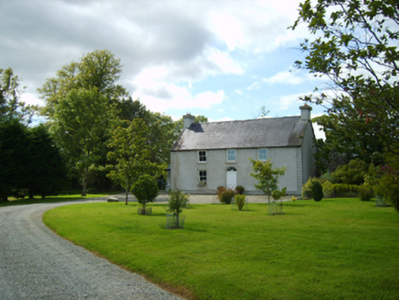Survey Data
Reg No
15703756
Rating
Regional
Categories of Special Interest
Architectural, Artistic, Historical, Social
Original Use
Farm house
In Use As
Farm house
Date
1700 - 1777
Coordinates
300135, 123761
Date Recorded
30/08/2007
Date Updated
--/--/--
Description
Detached three-bay single-storey farmhouse with half-dormer attic, extant 1777, on a rectangular plan originally three-bay single-storey double-pile with half-dormer attic. Occupied, 1885. Truncated, pre-1903, producing present composition. Vacant, 1911. Occupied, 1924. "Restored", 2003. Pitched slate roof with clay ridge tiles, lichen-covered concrete or rendered coping to gables with cement rendered chimney stacks to apexes having stepped capping supporting terracotta pots, and cast-iron rainwater goods on rendered eaves. Replacement cement rendered walls bellcast over rendered plinth with rusticated rendered piers to corners. Segmental-headed central door opening with cut-granite step threshold, and concealed dressings framing timber panelled double doors having fanlight. Square-headed window openings with cut-granite sills, and concealed dressings framing replacement two-over-two sash windows having part exposed sash boxes. Set in landscaped grounds.
Appraisal
A farmhouse representing an integral component of the eighteenth-century domestic built heritage of County Wexford with the architectural value of the composition, one annotated as "Killown [of] Brown Esquire" by Taylor and Skinner (1778 pl. 143), suggested by such attributes as the compact rectilinear plan form centred on a restrained doorcase showing a simple radial fanlight; the disproportionate bias of solid to void in the massing compounded by the diminishing in scale of the openings on each floor producing a graduated visual impression; and the high pitched roofline. Having been well maintained, the elementary form and massing survive intact together with quantities of the original or sympathetically replicated fabric, both to the exterior and to the interior allegedly repurposing timber work reclaimed from Ardcandrisk House (see 15703718), thus upholding much of the character or integrity of a farmhouse having historic connections with Robert Woodcock (Lewis 1837 II, 624); and the Walker family including Paul Walker (----; Lacy 1852, 238) and Henry Nixon Daniel Walker (d. 1912), 'Gentleman formerly of Killowen Cottage and late of Drinagh House County Wexford' (Calendars of Wills and Administrations 1912, 643).



